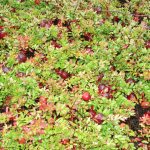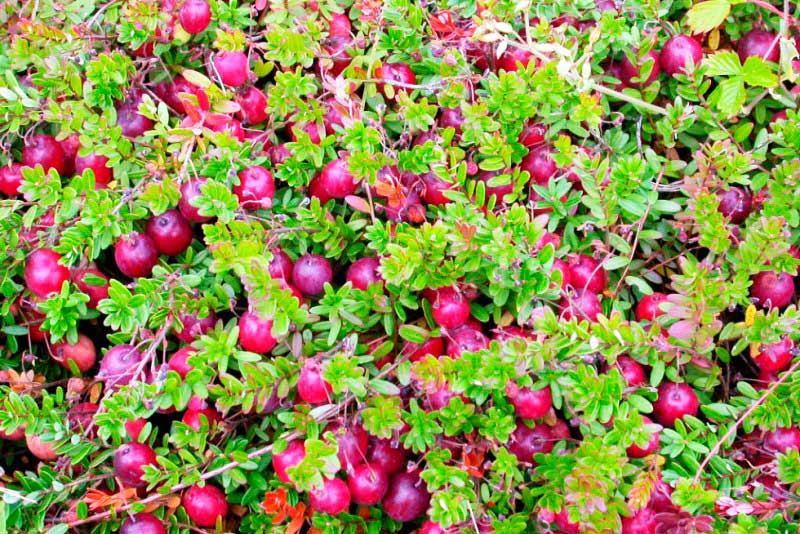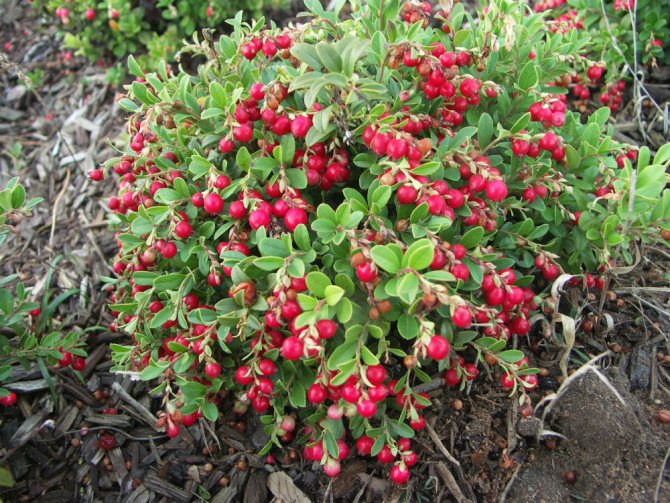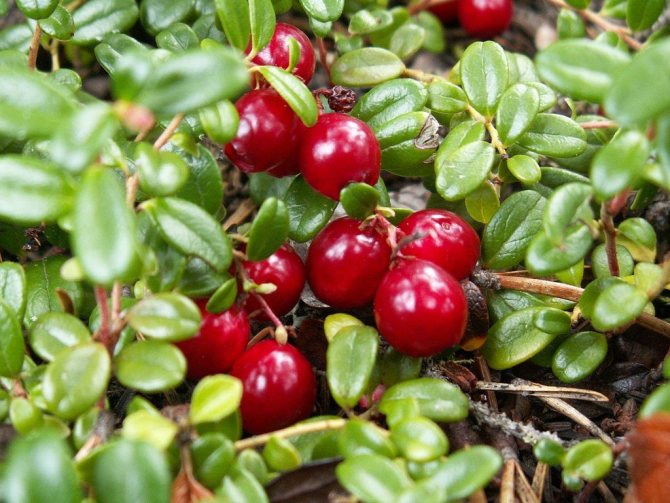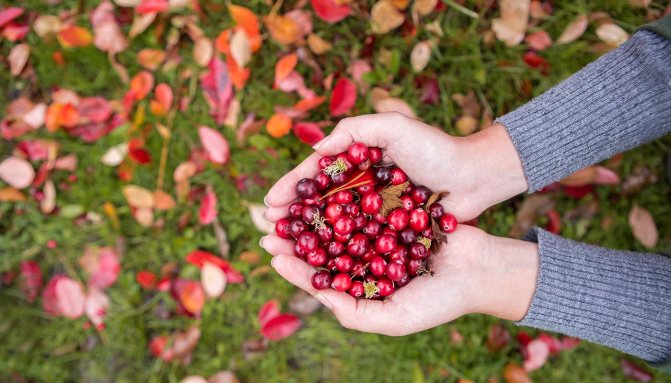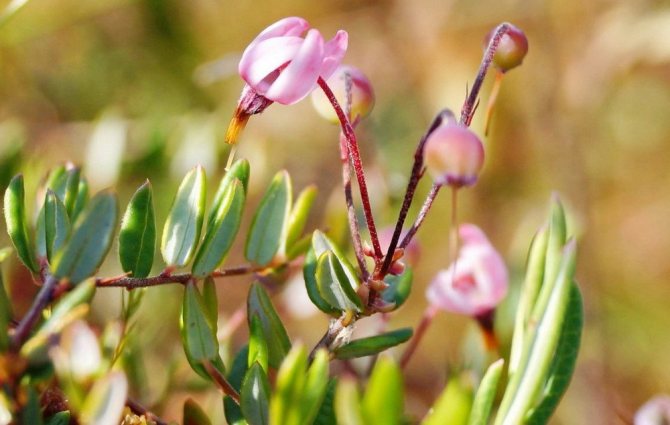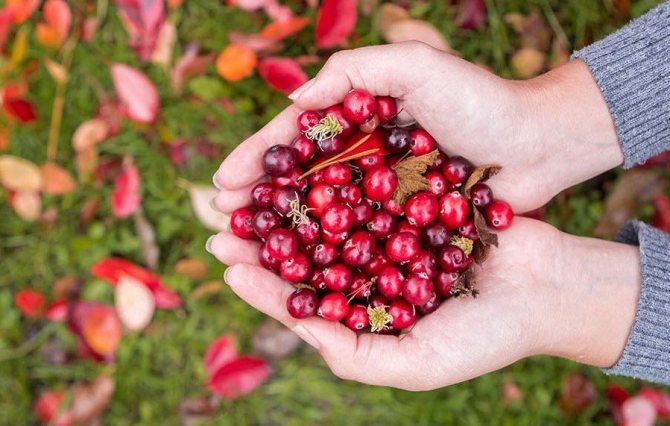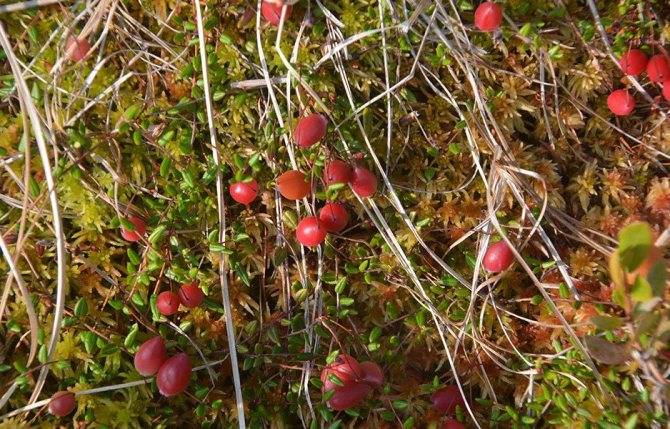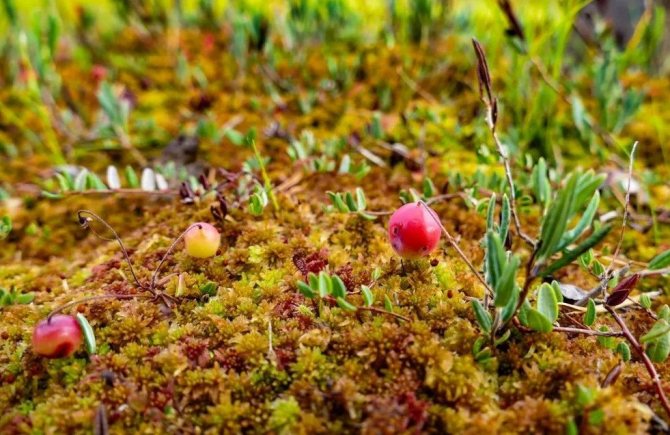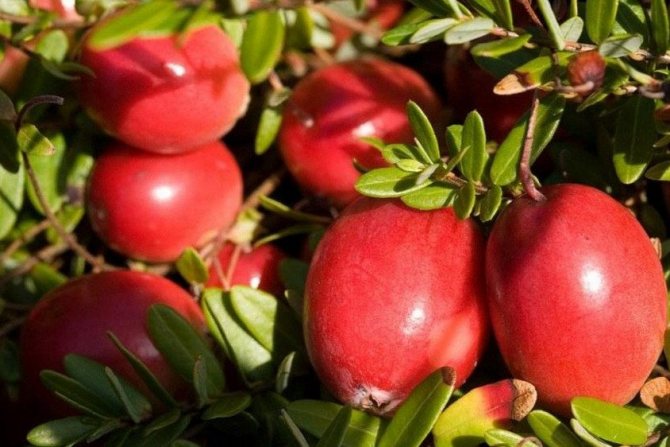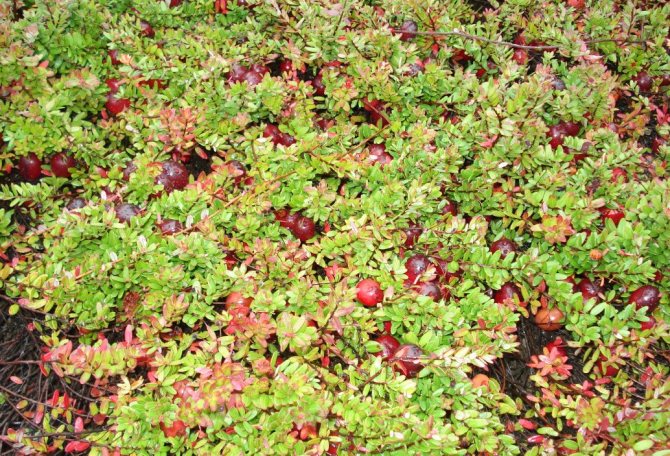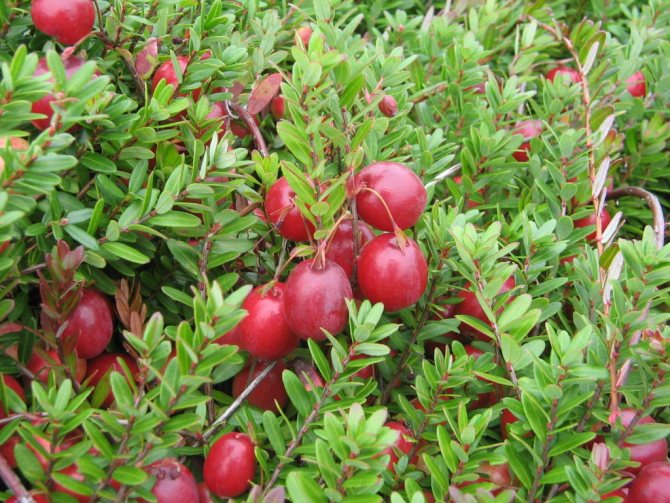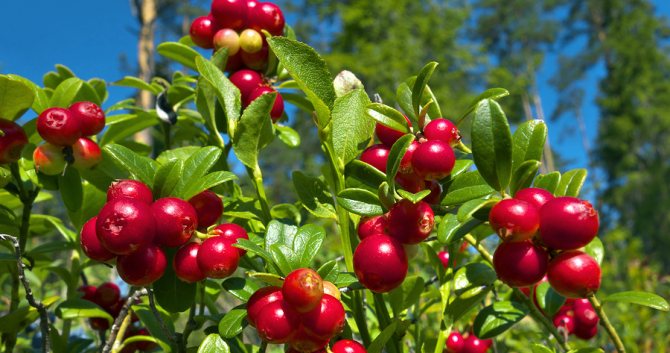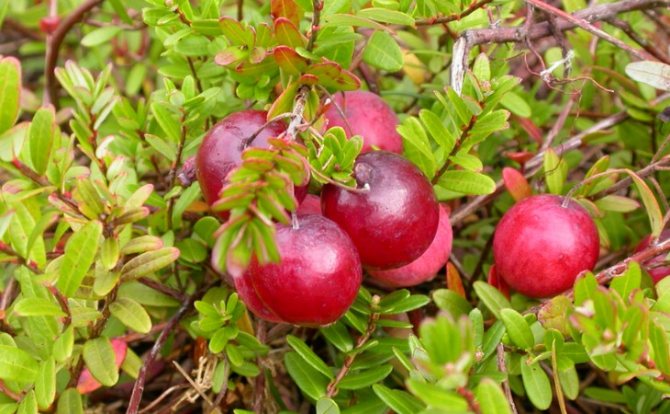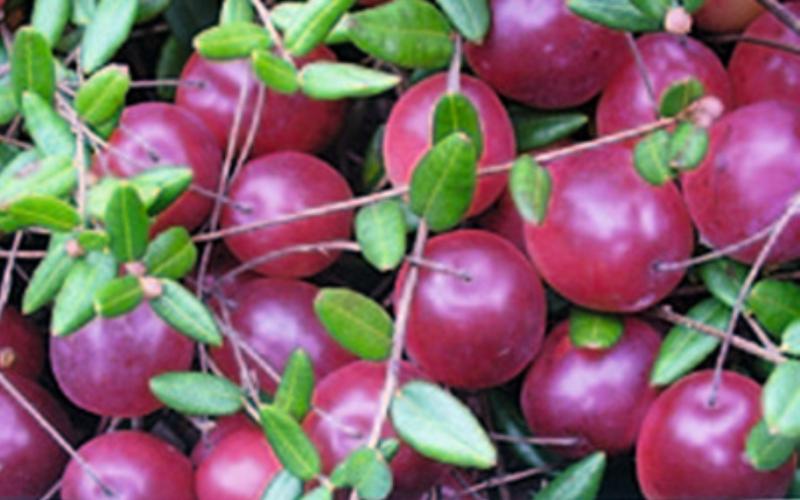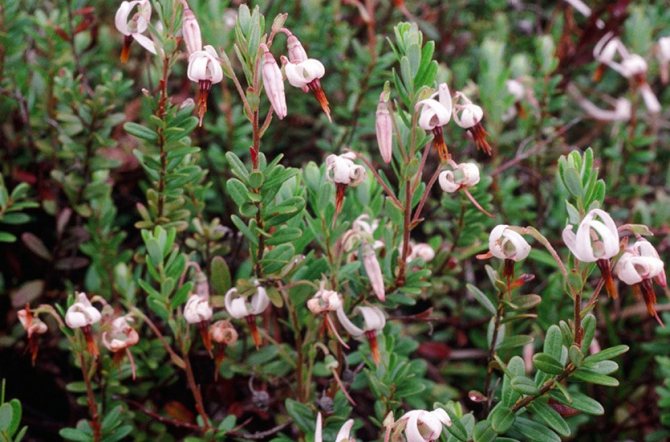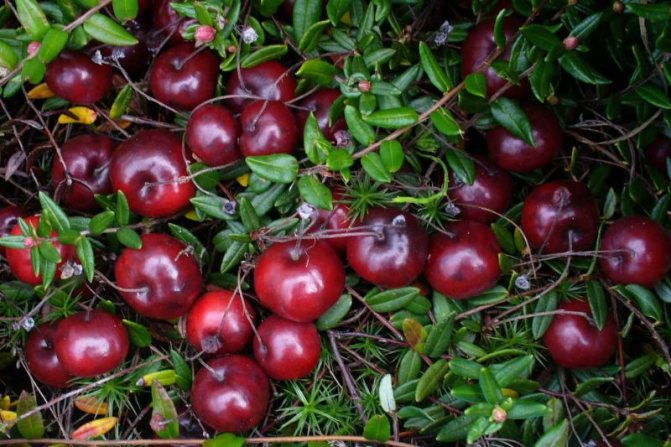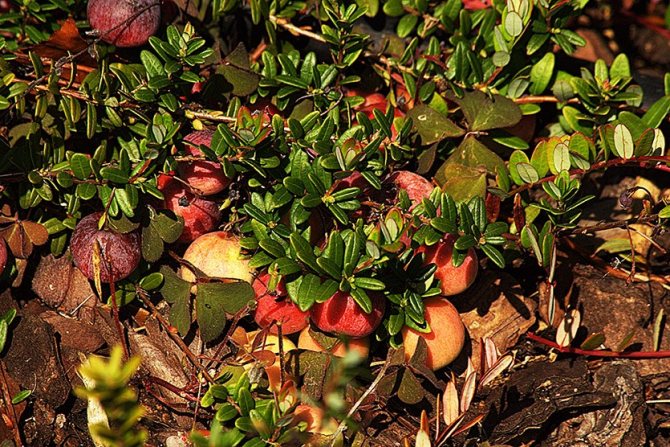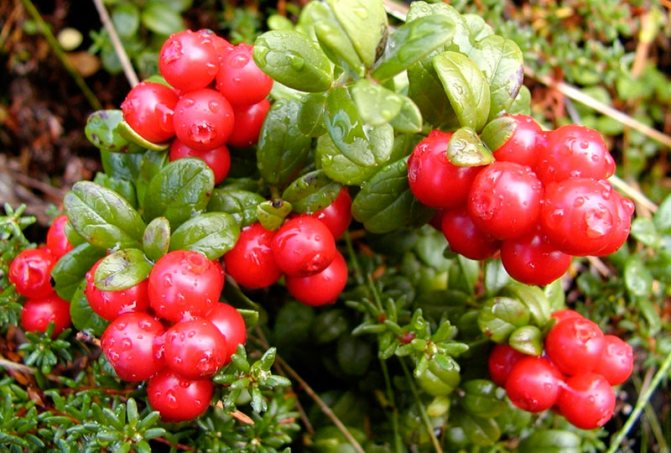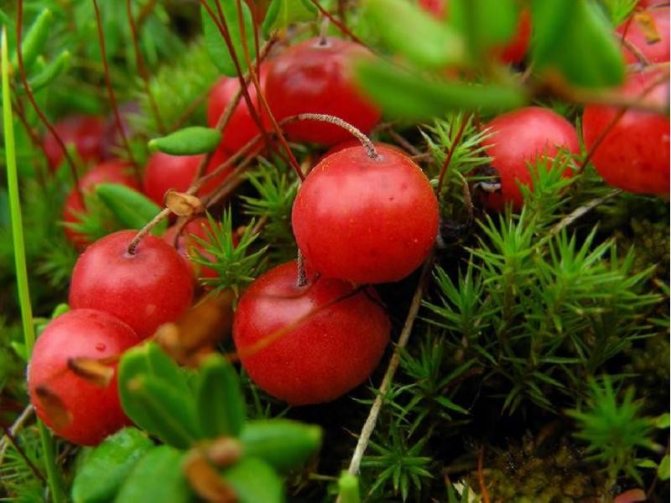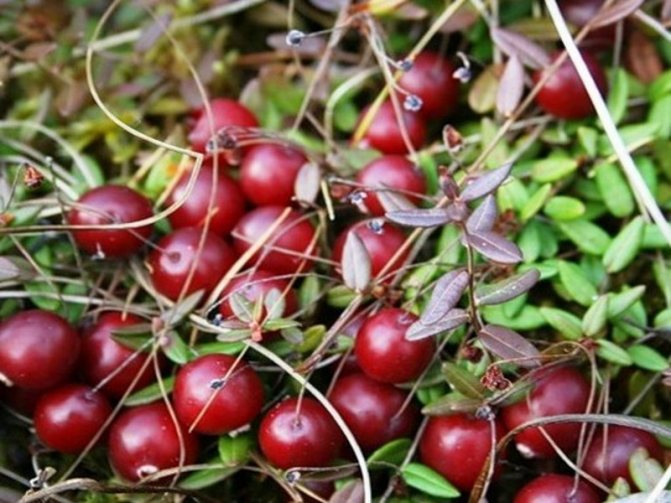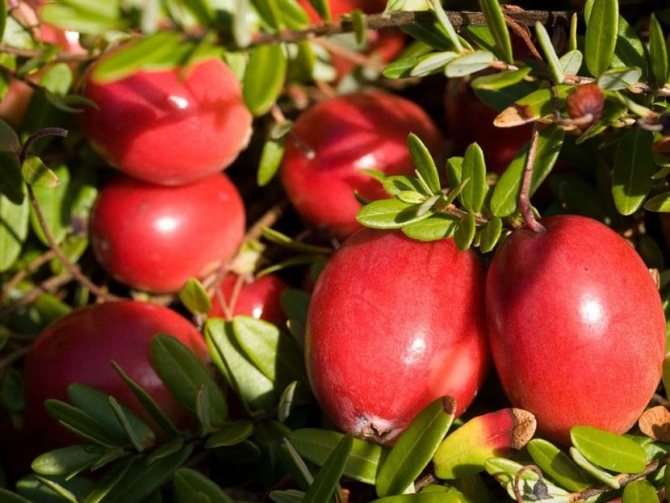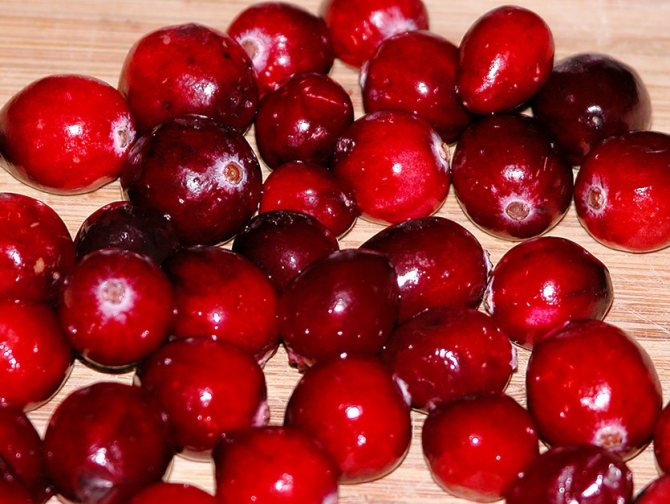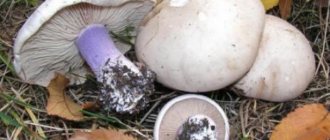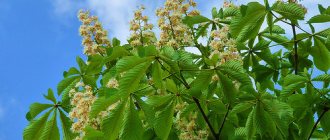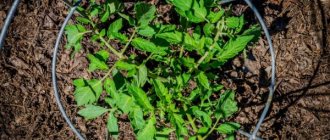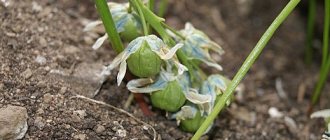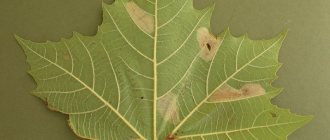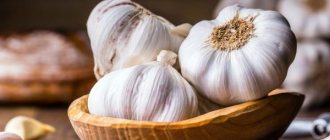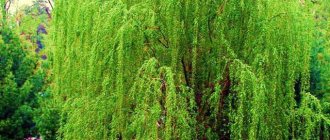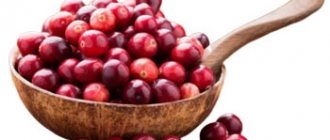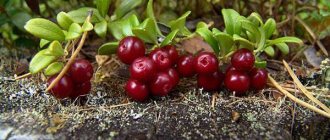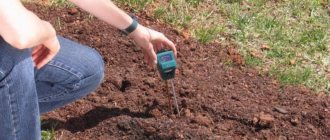Description, properties
Literally, cranberry means "sour berry". Under natural conditions, it grows in humid places: swamp, coniferous forests, etc. This culture is a storehouse of vitamins and useful microelements. In the biological description, cranberries are presented as an evergreen shrub, reaching a height of 0.5 m. The cultivation of this culture is not particularly difficult. Its root system is pivotal. The leaves are oblong, the fruit is small, red, about 1.5 cm in size. Large-fruited varieties are considered to be 1.5-2.5 cm in size.
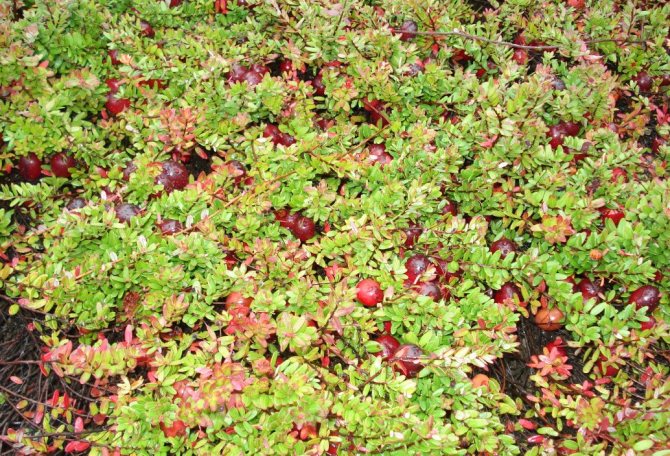
An evergreen bush blooms in May or June, the flowering period lasts 3 weeks. Inflorescences are pale purple or pink. Home cranberry shrub (large-fruited species) can be found today in many areas. According to some reviews, it is becoming even more popular than such fruit crops as black and red currants, gooseberries or strawberries.
Did you know? In England, cranberries used to be called "bear berries". The fact is that some witnesses watched grizzlies feast on the fruits of the bush.
Berries have excellent healing properties and are successfully used in the treatment of problems such as vitamin deficiency, vascular and gastrointestinal diseases. The garden view helps to remove heavy metals, toxins from the body, and also slows down the aging process.


How cranberries bloom
Garden cranberry is a large-fruited berry. The size of the fruits of this dwarf shrub varies from 12 to 25 mm, which is much larger than that of the wild marsh cranberry. Shoots grow horizontally, forming a spreading creeping shrub up to 1 m in diameter.
Garden cranberries bloom from May to June. Pollination occurs with the help of insects in a cross pattern. The photo below shows that the blooming cranberries form small, light pink flowers at the ends of the branches. At the end of flowering, they form fruit.
Variety selection
The northern region is rich in wild cranberry thickets that can easily withstand even the most severe frosts. The marsh species grows on peatlands and in the central part of the Russian Federation.
The domestication of this medicinal berry with the development of new cultural forms began only in the middle of the last century on the territory of the Kostroma experimental station. There were created large-fruited varieties, the agricultural technology of which is not particularly difficult. Many hybrids are not inferior in their characteristics to the best American varieties.
The most popular domestic species:
- Beauty of the North. Ripens late, at the end of September. Differs in frost resistance and resistance to many diseases. Berries are light red, 1.5 g in size, yield - 1.4 kg per 1 m².
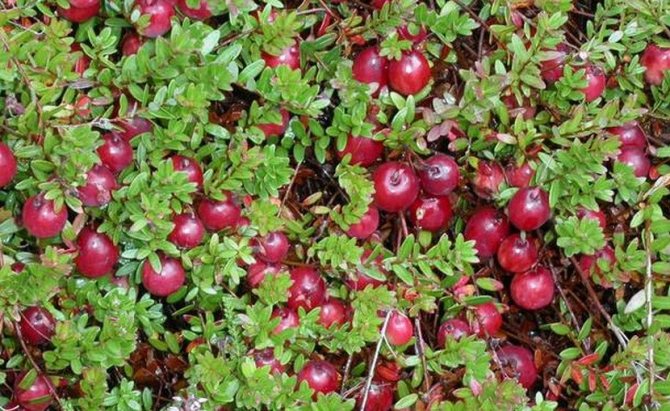

- Severyanka. Creeping species of average ripening period. Withstands frosts down to -33 ° C. Taken into cultivation by many summer residents. Berries are light red, 1.1 g in size, yield - 0.9 kg per 1 m².
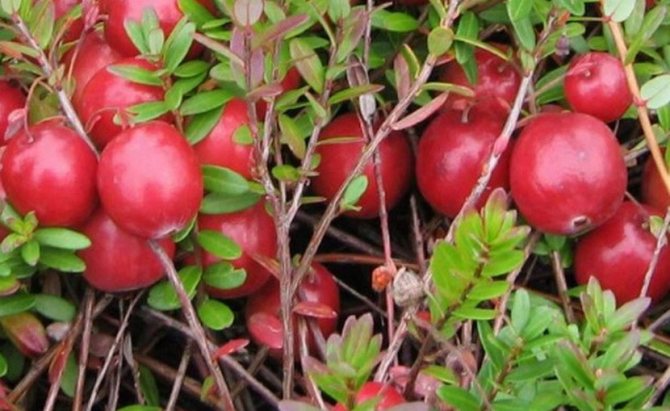

- Gift of Kostroma. Mid-season variety. A distinctive feature is a high yield (1 kg per 1 m²) and large fruits (size - 1.9 g). The color of the berries is dark red.
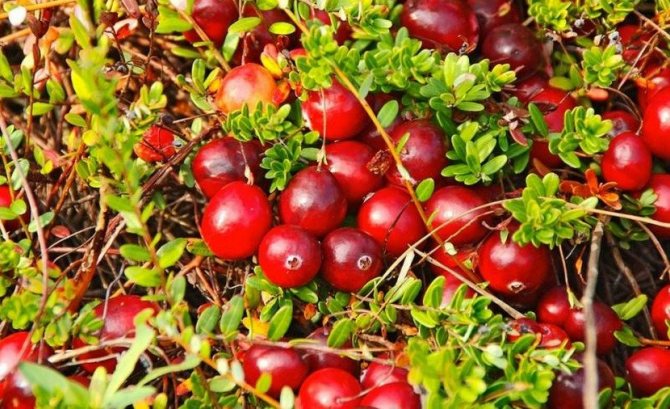

- Scarlet reserved. High-yielding late ripening variety. The berries are red, medium to large in size.
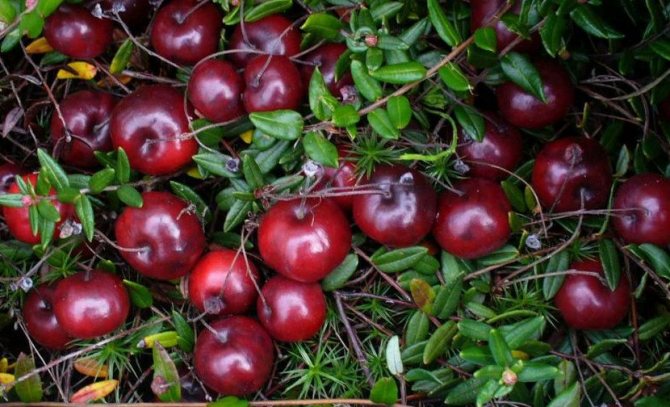

American varieties differ from European ones in a denser structure of berries, vertical shoots, less cold resistance and a longer growing season.The composition of the fruits is almost identical, and they began to cultivate it half a century earlier. Not the entire family of American cranberries is suitable for cultivation in domestic conditions. For most regions of the Russian Federation, only early and winter-hardy varieties are suitable:
- Ben Lear (Ben Lear). Early ripe species (August - early September). Berries are dark burgundy, large, 18-22 mm. 1.6–2 kg of berries are harvested from 1 m². Leaving is uncomplicated.
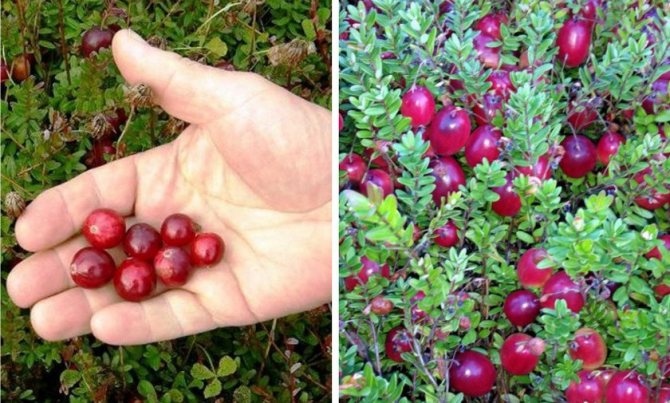

- Hoves (Howes). It tolerates frost and direct sunlight. Ripens late, in October. When ripe, the berries are red and 15–19 mm in size. Productivity - 1-1.9 kg per 1 m²
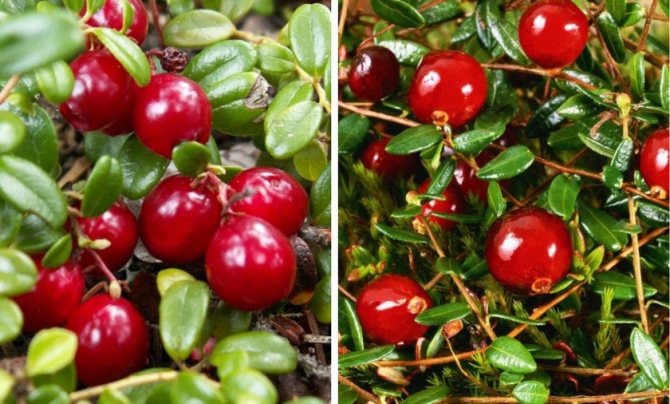

- Pilgrim (Pilgrim). Late maturing view (late September - early October). The main advantage is that the fruits can be stored for a long time. The berries are dark red, 20-24 mm in size. Productivity - 2–2.5 kg per 1 m².
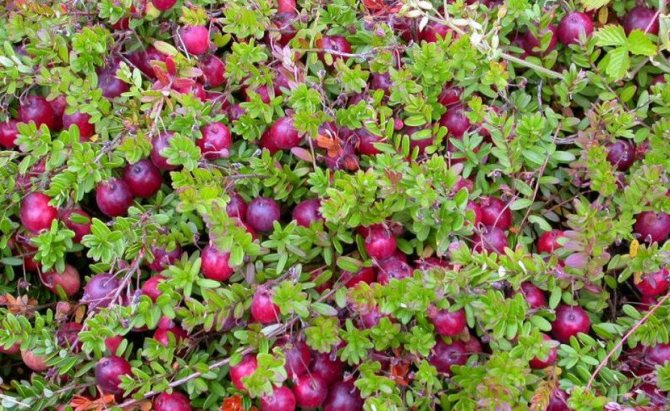

- Franklin (Franklin). A mid-season variety, ripens by mid-September. Resistant to major diseases. Fruits are medium in size (1.5 cm), dark red. Productivity - 1–1.5 kg per 1 m².
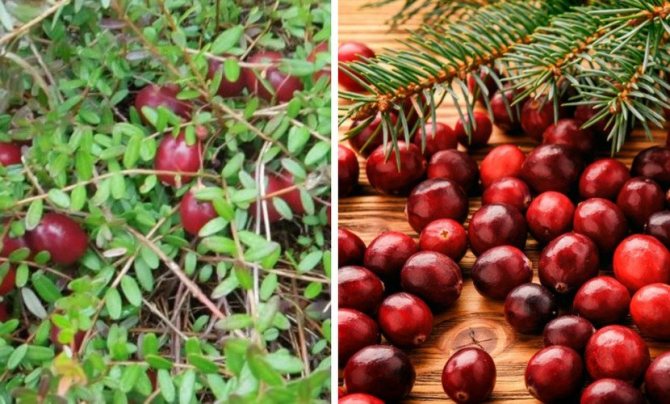

- Stevens (Stevens). The fruits are distinguished by good keeping quality (up to a year without processing), dark red, large (2–2.5 cm). Ripen at the end of September. Productivity - 1.8–2 kg per 1 m².
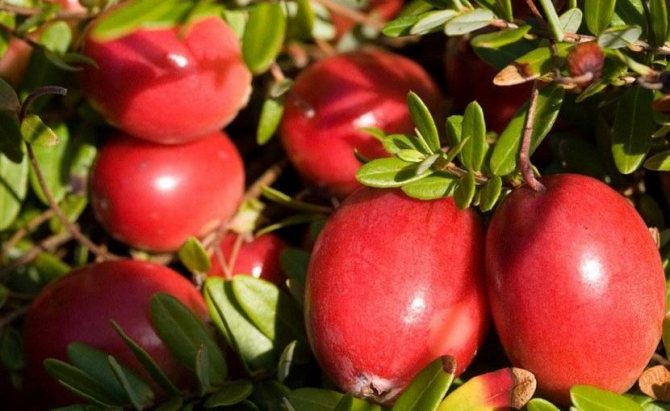

If the vegetable garden is located in the northern or northwest region, it is better to grow domestic varieties that thrive here in the wild. American varieties prefer an open area.
The central region of the Russian Federation will be a good area for growing almost all varieties of cranberries. In a good season, you can get a generous harvest of large-fruited species. Chernozem is a wonderful region where crops are rarely fed, so there are ideal conditions for growing all varieties of sour berries.
Important! In the south, cranberries are practically not grown due to high temperatures and dry air.
Where does garden cranberry grow?
Earlier, before domestication, cranberries grew only in swampy areas, where the acidity of the soil was significantly increased. North America is considered her homeland., and the first explorers of America called it the crane berry.
Only a couple of centuries ago, cranberries were harvested in swamps, and now they are cultivated on a large scale on plantations, where favorable conditions for growth and conditions that are most similar to natural ones have been created.
In Russia, various varieties of cranberries are most widespread in Karelia, Kostroma and Leningrad region.
Cranberries are sometimes called northern lemon because of their high content of citric acid, vitamin C, quinic acid, vitamin B, PP, potassium, iron, phosphorus, cobalt, boron and manganese.
With the right conditions and proper care, cranberry yields can reach up to 11 tons per hectare of plantations.
Cranberries are now widely used in the production of confectionery, juice drinks and fruit drinks, jams and jellies, and therefore, the cultivation of this plant is not only in demand, but can also become a good source of income.
The program "Living Healthy!" Will tell you about cranberries:
https://youtu.be/ms2LeKFxWOU
Reproduction
The culture propagates by shoots. It is better if the planting material is annual. Twigs are cut into small cuttings 10 cm long and planted in the ground. The procedure takes place in May. Then the cuttings are sprinkled with sand in the middle to leave 2–2.5 cm on each side. This heather species loves moisture, so the substrate must be moist for the entire period until the plant takes root.
As soon as new shoots appear, this means that the cutting has taken root and a root system has formed. Some gardeners propagate cranberries by seed. The soil is taken the same as for planting cuttings in an open area. Seed material must be exclusively freshly harvested.
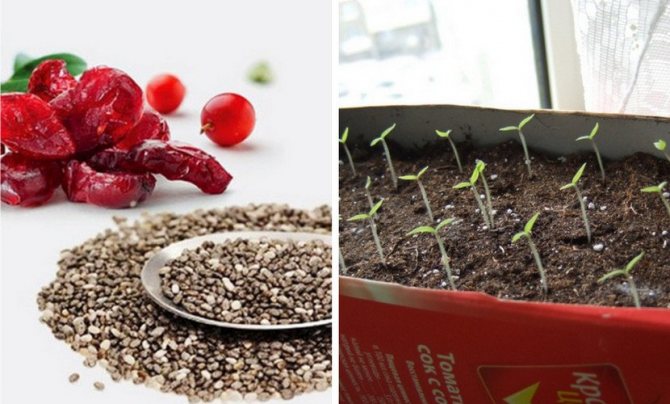

A plant grown from seed does not inherit maternal traits.
After the seed is placed in the substrate, it is watered abundantly, covered with glass and placed in a warm, sunny place. After planting, the soil is constantly moistened, and the room in which the seedlings are located is ventilated. If mold appears on the surface of the soil from the abundance of moisture, it and the pot are treated with fungicides.
Read on for information on how to propagate cranberries.
After 20-30 days, the first shoots will appear, and the glass can be removed. The watering regime is left. As soon as 4-5 leaves appear at the seedlings, a pick is carried out or immediately sent to the greenhouse. Rooted seedlings can be planted from April to October. Leave 10 cm between the plants. In schools, cuttings will have to be nursed for 1-2 years.
Video: Cutting cranberries
Cranberry care
Pay special attention to cranberries during the early stages of growth. In the first couple of years, carefully remove the weeds around the plant, as well as constantly loosen, water and fertilize the soil. Every time you water, replenish the peat layer on the soil surface. After three years, care can be minimized - good watering of the cranberries is enough.
Caring for the plant does not stop even with the arrival of winter... A slight frost with abundant snow, cranberries survive quite well. But if winter does not make you happy with snow or severe frosts come, the bush should be covered. A layer of ice will help protect the plant from freezing. To do this, upon the arrival of sub-zero temperatures, the plant is watered with water, after which the bush will be under a layer of protective crust.
Landing
To get good results when growing cranberries in any region (including the Moscow region, Siberia), it is necessary to take into account all the features of the culture.
Site selection and site preparation
The personal plot on which it is planned to plant cranberries should be well lit and characterized by high humidity - in nature, the swampy species prefers swampy soil. It is good if the groundwater is close (40–45 cm) to the surface. If the garden has a stream, a small lake or a pond, then it is advisable to plant the bushes on the shore. In this case, the presence of nearby trees will not be an obstacle - a little shading will not harm the plant.
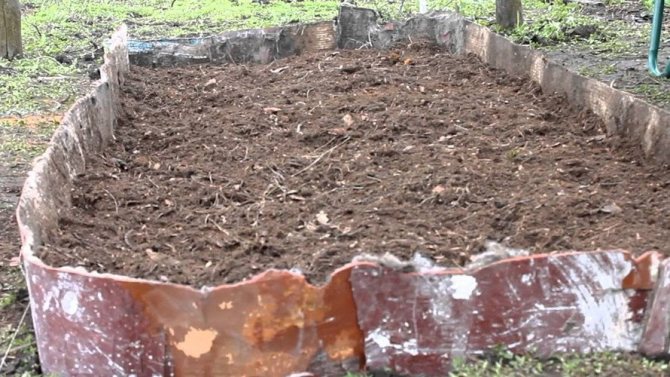

In order for the seedling to take root well, the place needs to be prepared in the fall. In September, the site is fenced off. Around the perimeter, a material that does not rot (slate, plastic, roofing material) is dug in to a depth of 20 cm. As a result, the plantation plot should have a small fence 20-30 cm high.
Before planting, the soil is loosened and the acidic background is corrected. They dig the earth to a depth of 8–11 cm and level it. In the process of this procedure, it becomes clear what kind of humidity there is. If the soil is too dry, it is watered (1 m² bucket).
The soil
The forest is distinguished by peat soil, therefore this option is favorable for cranberries. The optimum acidity level is pH 3.5–4.5. You can use a forest soil mixture with sphagnum. If the soil at the dacha differs significantly from the required parameters, then the top layer (20–25 cm) on the site is removed, and a more suitable substrate is poured in its place. Prepare it by taking the following components:
- sand - 1 part;
- peat - 2 parts;
- forest humus - 1 part;
- forest land - 1 part;
- rotted needles.
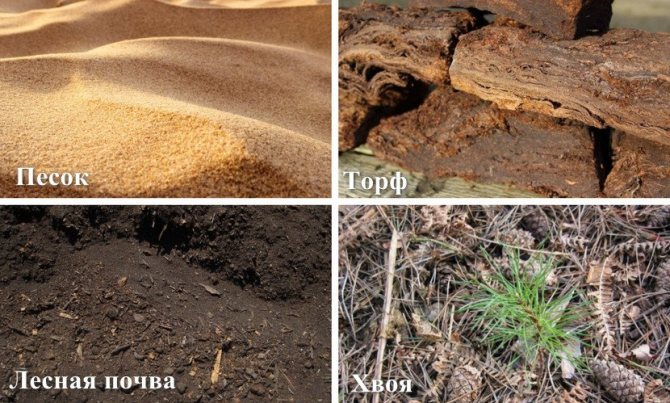

Scheme
Cranberry planting can be done in spring. If the process is carried out after winter, the soil should warm up by 8-10 cm. Just before planting, holes 10 cm deep are dug in the ground. If you plan to plant several bushes, leave a distance of 20 cm between them.
Important! It is undesirable to plant cranberries in autumn.
The holes are watered with warm water and placed on 2 seedlings 15–20 cm high. The holes are covered with soil, not tamped.The bush will take root well, and will begin to bear fruit in the third year of life. A stable crop can be harvested from the fourth year after planting. For the first 2 years, cranberries will simply serve as a decoration of the site.
Video: Planting cranberries
Classification [edit | edit code]
Taxonomic position [edit | edit code]
Different sources indicate a different rank of the taxon Oxycoccus
(Cranberry); usually this taxon is considered either as one of two subgenera of the genus Vaccinium (
Vaccinium
subgen.
Oxycoccus
), or as one of more than thirty sections of the same kind (
Vaccinium
sect.
Oxycoccus
). In Russian-language literature, the taxon
Oxycoccus
is still often regarded as an independent genus [3].
Cranberries are one of the recommended natural foods with proven health benefits. However, the beneficial properties of excellent cranberries may have contraindications in the treatment of a particular group of people.
Collection and procurement
Cranberries are a berry that grows in the acidic peat soil typical of mountainous regions. The United States and Canada specialize in the cultivation of cranberry plantations. There are huge swamp-like areas dedicated to the cultivation of these valuable berries. In our country, it is grown only by gardeners.
We are all used to picking cranberries in the forests, but few people know that they can also be grown on our own personal plot. Forest cranberries are slightly different from garden cranberries, including in agricultural technology.
Cranberry is an unpretentious plant, it does not need fertile soil. It is enough to raise the bed 15 cm and add sour peat. Garden cranberries, unlike wild ones, do not tolerate root flooding. Saplings are placed at a distance of 15-20 cm from each other. Disembarkation takes place at the end of April, at the beginning of May.
It blooms in the first half of summer. For medicinal purposes, the leaves are collected, which are subsequently dried to make tea. They are harvested before or during flowering. This plant is very hardy and can withstand temperatures as low as -40 ° C.
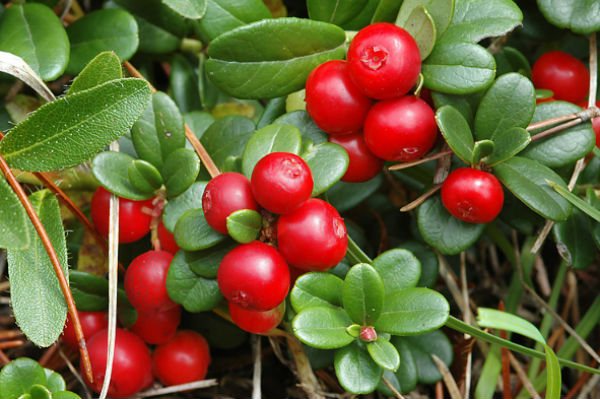

Cranberry bush with berries
Unlike leaves, cranberries need to be picked in three stages in the fall. At the beginning of September, the cranberries are still hard. But filling it with cold water, it can be stored for the whole winter and at the same time it will ripen and soften. Please note that at the onset of the first frost, the water must be drained, and the cranberries must be frozen and stored in a barrel in a cold place.
Berries harvested in late autumn are the tastiest and most juicy. It must be remembered that cranberries are perishable, so it is best to send them to freeze. In this form, she can lie for up to 9 months.
Cranberries, which have caught the winter frosts, are harvested after the snow melts. This happens in early spring. It is still sweet, but its acidity decreases and also does not last long.
It is important to remember that cranberries are best harvested by hand, as industrial tools can damage young shoots and reduce future yields.
Structure
Cranberry has a lot of vitamins, namely:
- microelements;
- minerals;
- tannins and flavonoids;
- essential fatty acids - linoleic acid (OMEGA-6), alpha-linoleic acid (OMEGA-3);
- carotenoids and phytosterols, with the help of which the human body is protected from the introduction of microbes into cells;
- cranberries contain various types of sugar, pectin, vitamins, organic acids;
- vitamin C content is equivalent to lemon, orange, grapefruit, garden strawberry;
- it also contains thiamine (vitamin B), riboflavin (vitamin B2), folic acid (vitamin B9), pyridoxine (vitamin B6), niacin (vitamin PP).
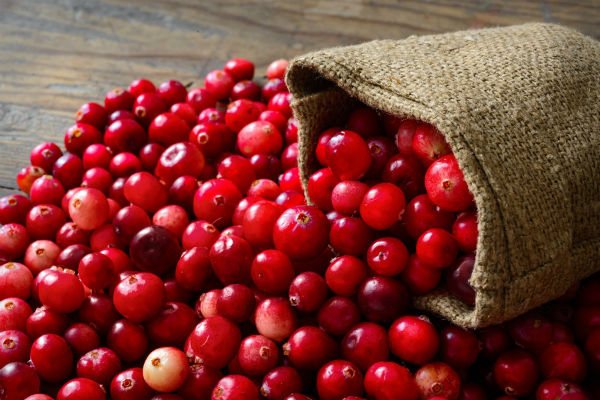

Cranberries are a storehouse of vitamins and minerals
100 g of cranberries contain:
- 86.5% water;
- 49 kcal;
- 0.4 g protein;
- 0.2 g fat;
- 12.7 g carbohydrates;
- 8.5 g sugar;
- 4 grams of fiber.
Useful and medicinal properties
Before you find out what contraindications exist for cranberries, it is necessary to note all of its beneficial properties and vitamins that it contains. The following should be noted:
- cranberries are a powerful antioxidant. Vitamin A effectively neutralizes free radicals, and fruits also have antiseptic properties. There is evidence that about 20 million people in Europe use cranberries as an antioxidant;
- This sweet fruit contains about 6% arbutin, 8% catechins, which are antioxidants, caffeic acid and quite a lot of vitamin C;
- tocotrienol is a rare form of vitamin E found in wild fruits. It is considered an antioxidant that is 40-60 times more effective than tocopherol, the most common form of vitamin E. Of all natural oils, cranberry is said to contain the highest amount of tocotrienol;
- cranberries are also high in iron. A huge plus of this berry is that they have a low glycemic index, as a result of which they are absorbed slowly;
- it is also a good source of Omega-3 plant metabolites for metabolism;
- cranberry is a diuretic. Therefore, it is recommended to use it for people suffering from kidney and urinary tract diseases;


Cranberries can be added to tea and made into compote
- for women, cranberries are just as important. After birth complications, with cystitis and other gynecological diseases, it is used together with antibiotics, thereby increasing the effectiveness of drugs;
- the medicinal properties of cranberries also have contraindications. People who have inflammatory diseases of the liver, stomach and intestines are not recommended to use this berry;
- Scientists have proven that cranberries are a unique remedy for food poisoning. It reduces the number of bacteria Salmonella and Escherichia coli;
- for burns, purulent wounds, psoriasis and eczema, cranberries are also used in the form of lotions;
- experts recommend controlling high blood pressure not only with pills, but also with the addition of fruits or cranberry supplements. The beneficial properties of cranberries include pectin, tannins, minerals and have no contraindications for pressure. This composition keeps elastic and healthy blood vessels, protects against the formation of fatty plaques on their walls from constriction and hypertensive attacks;
- many patients with diabetes mellitus are interested in the answer to the question: "What are the beneficial properties of cranberries in diabetes and are there any contraindications to its use?" Natural honey is present in cranberries, which makes them suitable for diabetic patients as well as for the prevention of diabetes.
Application
Most of the cranberry crop is converted into juice, sauce, or candied dried fruit. Fresh cranberries can be frozen at home and thus stored for more than nine months and then used directly without thawing. Therefore, very often parents use frozen cranberries in the preparation of jam or jelly for their children.
Seasonal care features
After the bushes are planted, the leaving process begins. First of all, they monitor the level of humidity. The garden bed is watered at least twice a week at the rate of 10 liters per 1 m² of planting. Watering should be done more frequently on hot days and less frequently on rainy days. Too much soil should not be poured - it is enough to soak only the top layer. From mid-August, watering is reduced - the plant must prepare for winter.
The first time the cutting is fed after 15–20 days. Superphosphate (15 g per 1 m²) and potassium sulfate (7 g per 1 m²) are added to the soil. Nitrogen fertilizers are added in the spring, at the end of April and May. Top dressing for 1 m² should include:
- ammonium sulfate - 3-4 g;
- double superphosphate - 6 g;
- potassium sulfate - 3-4 g.
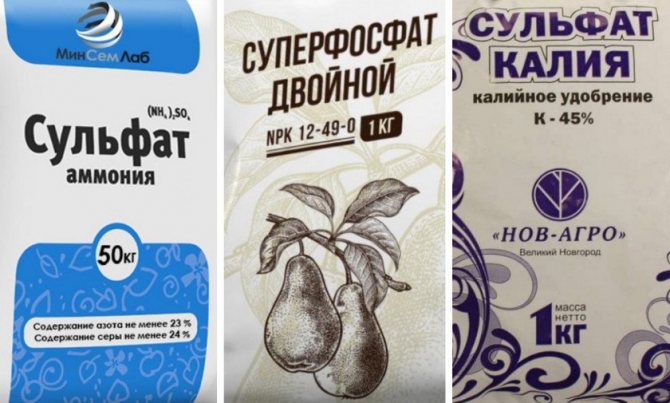

Since the shoot will be cultivated in one place for more than one year, it is recommended to monitor its purity - weeds are removed as they appear. For the first 3 years, weeding and loosening of the soil should be a regular procedure. Weed plantings 3-4 times per season. The work is carried out carefully, trying not to capture the rooted seedlings. If the soil settles on the plantation, then peat is simply added on top.
Important! Chicken droppings, manure, compost cannot be used - they will ruin the plant due to excessive nitrogen content.
Cranberry plantations are periodically mulched with sand or peat chips: they provide favorable conditions for the development of the root system and the entire plant. Sand once every 2-3 years: work is performed in early spring, before the growth of the culture. Sand is scattered 2-3 cm thick throughout the plantation.
Plantings with bushes older than three years must be mulched every 3-4 years with peat chips.
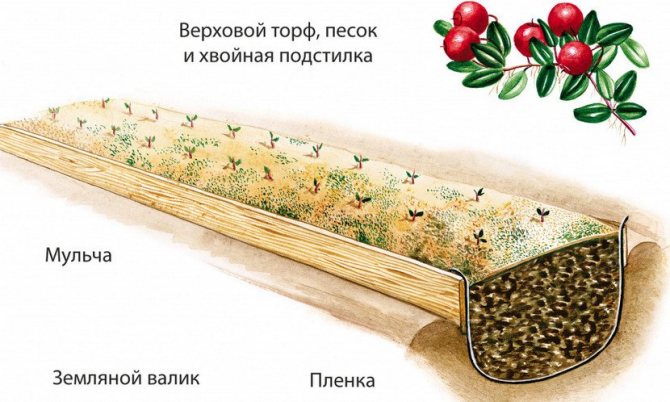

Cultivation [edit | edit code]
Cultivation history [edit | edit code]
The beginning of the cultivation of cranberries is believed to be 1816, when an amateur gardener Henry Hall (USA, Massachusetts) accidentally noticed that wild cranberries, sprinkled with sand from neighboring dunes, bear fruit better than the one that was not sprinkled. The first attempts to cultivate cranberries were undertaken by improving its natural thickets - individual sections of bogs were leveled, sanding and reclamation work was carried out.
The first information about the creation of artificial industrial cranberry plantations dates back to 1833. Since then, cranberry cultivation has grown rapidly, especially in the United States, where the cranberry plantation is now a typical family business.
In Russia, the first small plantation of large-fruited cranberries was created at the end of the 19th century in the St. Petersburg Botanical Garden by E. Regel, but at the beginning of the 20th century, research was interrupted. Interest in large-fruited cranberry arose again in the 1960s-1970s, and attempts to cultivate it were started both in Russia and in the republics of the former USSR - Lithuania, Latvia, Belarus.
At present, on the territory of the former USSR, the greatest successes in the industrial cultivation of large-fruited cranberries have been achieved in Belarus. There are several large industrial plantations and many small private farms that grow large-fruited cranberries on an area of 1-3 hectares [15].
In Russia, there is currently only one large plantation of large-fruited cranberries (Kostroma region) [16].
Marsh cranberry is a plant uncharacteristic for the USA and Canada - pioneer countries in the cultivation of cranberries, so for a long time it remained on the sidelines. However, in the second half of the 20th century in the USSR, work began on the cultivation of marsh cranberries. Currently, seven varieties of marsh cranberry have been registered in Russia [17].
Spring pruning
The main purpose of pruning in spring is to form a bush. Today they use the following schemes:
- Horizontal spreading. Aimed at stimulating the development of side branches. The upper shoots are removed.
- Vertical compact. Powerful side shoots are cut off.
Work is carried out in May. In addition, by the sixth year of life, a dense layer forms on the plant, which greatly shades the fruits. The ripening process is delayed, the berries are poorly colored. Accordingly, sometimes (the frequency is determined by the density of the layer) at the beginning of the growing season or in the fall, after harvest, the creeping branches are cut. Shoots protruding above erect tops are cut off. Cutting shoots 2-3 cm wide is allowed, not cut shoots are left nearby.


Certain preparation for the procedure is not needed, a sharp instrument (pruner, knife or scissors) is enough.
Cranberry - its harsh habitat and the possibility of planting near the house
There is an opinion that cranberries grow exclusively in swamps, where there is a lot of peat, shade and, most importantly, moisture.Partly yes, and the native places of culture are the Far East, the Urals, Siberia, Sakhalin. But this does not mean that it cannot be grown like currants or gooseberries near the house in other regions of our country. After all, it is very convenient, not everyone can travel far into the forest, walk through the swamps to pick a miracle berry. In addition, there have been different varieties for a long time, which have expanded the possibilities of summer residents.
Do I need to make a swamp or fill the designated place on the site with water in order to grow garden cranberries? Not, of course, unless you have such a swamp nearby that nature itself created. The culture needs plenty of water - yes, but the same cucumbers during the season need to be poured every day, and yes, also with warm water, in order to harvest. You can find all the features of growing red berries with us. In the meantime, let's talk about the benefits, and why is it all, in general, necessary. Well, for those who don't know how unique the berry is.
Preparing for winter
Despite the fact that cranberries are considered a northern berry, their home varieties require protection from frost. The best option for this is snow cover, which is characterized by excellent thermal insulation properties. But it is not a sufficiently reliable remedy - the winds can blow the snow cap off the beds, and during the thaw, the snow simply melts.
For these reasons, before winter, late autumn, material is selected for shelter.:
- spunbond;
- spruce branches;
- sackcloth.
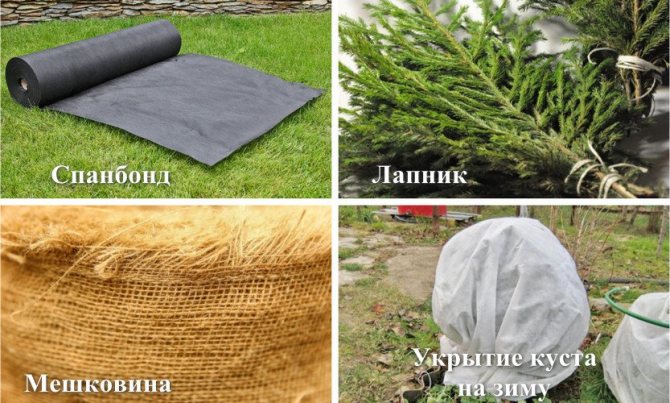

After thawing the soil in the spring, the shelter is removed. Winter protection is needed not only from frost. In dry, windy weather, an unprotected plant can die if the temperature is kept above the critical level for several days. The root system in frozen soil does not work and does not supply the aboveground part of moisture - as a result, the plant dies from desiccation.
Important! Straw or fallen leaves cannot be used as a shelter: rodents can settle in it.
In the off-season, you also need to take care of protecting the plantation from frost. Sprinkler irrigation is an ideal protection method. At night, at temperatures of 0 ° C and below, watering is turned on. If this method cannot be used, then on the eve of frost, the beds are well watered and covered with any available material (polyethylene, foam rubber, straw, spunbond, etc.).
"Queen" of berries
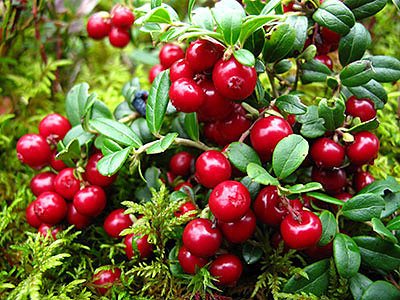

The first mentions of the healing properties of cranberries can be found in treatises, works of medical scientists of Ancient Rome. They note that not only berries, but also cranberry leaves can be used as medicinal products. The Indians used dried berries as a preservative. They were thoroughly grinded, ground and sprinkled with the resulting powder pieces of meat, which made it possible to extend its shelf life.
In the wild, cranberries are found everywhere, choosing swampy, moss-covered places for their growth. This low, creeping evergreen is loved by the inhabitants of Europe. They noticed the similarity of the stalk, which has a small flower at the end, with the neck and head of a crane, and gave it the name crane berry. But the British noted the addiction to berries on the part of bears, who gladly climb into the berry and feast on cranberries. On the territory of Russia, the queen of berries "settled" in the central part, northern regions, in the Urals, the Far East, Kamchatka, Sakhalin.
Low-growing bushes of cranberries are covered with evergreen oval leaves. Juicy berries are usually round, spherical, although varieties with elliptical fruits are also found. In percentage, they are 90% water and, depending on the degree of maturity, can have a color from pale pink to burgundy red.
Diseases and pests
Despite the fact that cranberries have strong immunity, some diseases can strike it. For protection and as a preventive measure, after harvesting, cranberry plantings are poured with a 2-centimeter layer of water.The procedure is performed when the temperature indicators are stable at –4… –5 ° C. When the water freezes, repeat watering. Do this until the plant is completely covered with water.
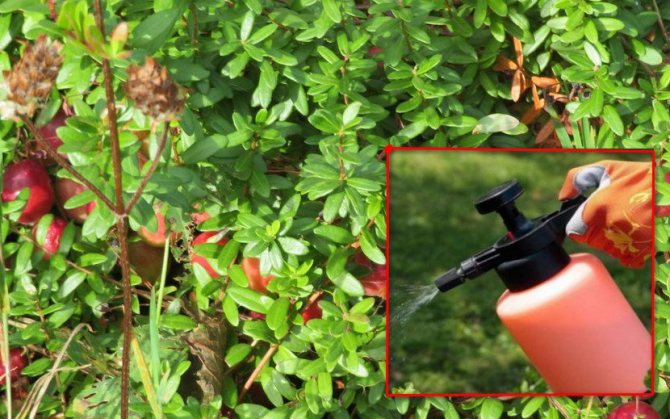

The development of fungal diseases can prevent the treatment of plantings with fungicides. The bushes are sprayed 3-4 times during the growing season.
In the spring, during budding, plantings are treated with Bordeaux liquid (1% solution). Pest insects rarely infect cranberries. They practically do not harm her. The main condition is regular planting care. Insecticidal preparations are used in extreme cases - no later than 1.5 months before harvest.
The most dangerous diseases for cranberry plantings are:
- Gray rot (botrytis). Occurs during cold, humid periods. Symptoms: Large shoots and foliage are covered with a gray bloom. Control methods: spraying the bush with copper oxychloride or Bordeaux liquid.
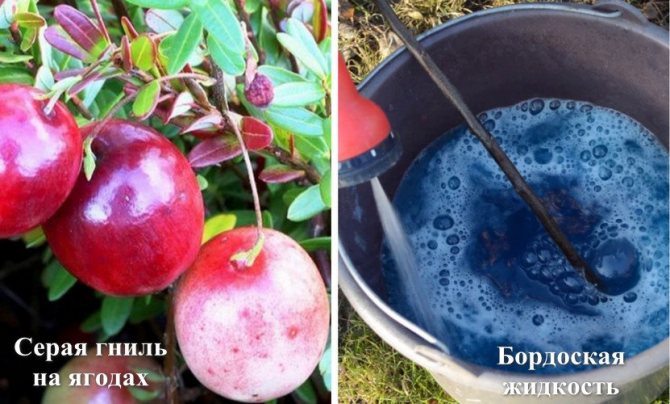

- Red spot. The disease is of fungal origin. Leads to deformation and death of branches. To get rid of using "Fundazol" and "Topsin-M".
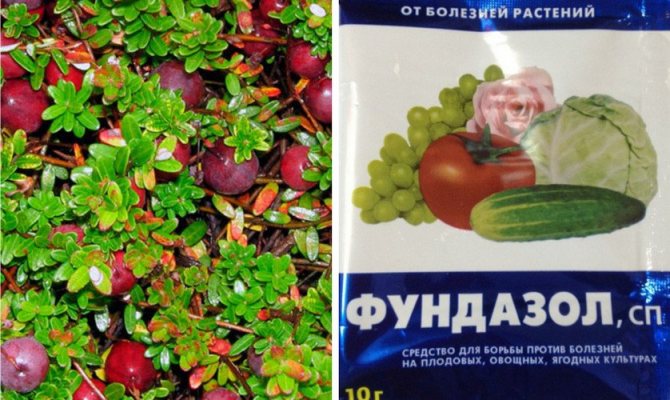

- Cytosporosis. It penetrates the plant through small cracks and infects it from the inside. The methods of struggle are the same as with gray rot.


- Phomopsis... Provokes drying of the ends of branches without wilting. It affects the plant in hot weather. Control methods: any systemic fungicide.
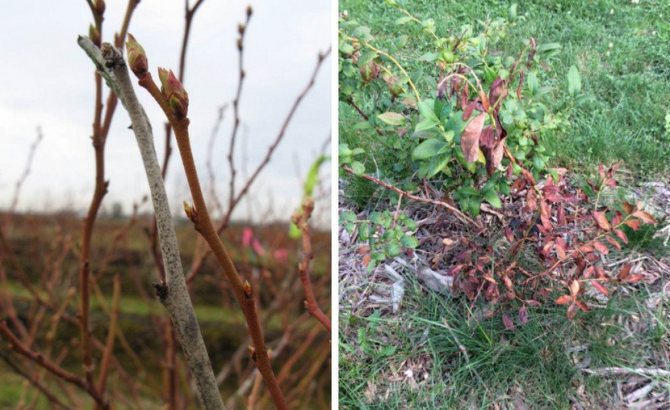

- Terry. A viral disease that has another name - growth. Affected branches rise upward, foliage becomes smaller and adjoins the shoots. A diseased plant does not yield a crop, and the berries that appear grow small, with a changed shape. There is no way to fight the virus - the plant is simply removed and burned.
Did you know? First domesticate
cranberry becameAmerican G. Hall at the beginning of the XIX century. The plant was taken into industrial development at the end of the 20th century: since then, more than 200 varieties of home cranberries have been bred. - Monilial burn. A fungal disease that affects the tops of the branches: they turn brown, wither and dry out. To get rid of, use "Topsin-M" or "Ronilan".
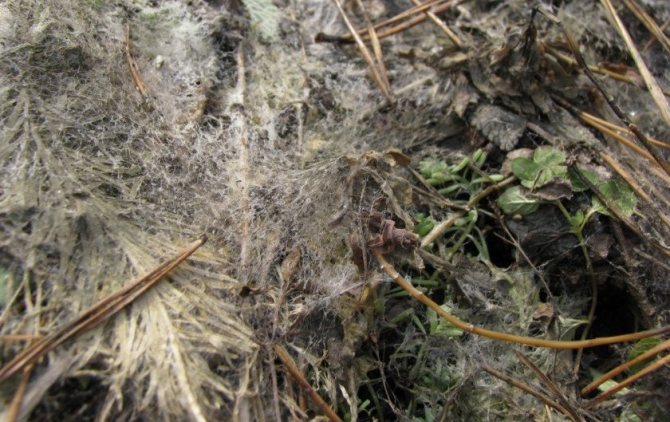

About the benefits and uses of cranberries
The beneficial properties of cranberries are due to their high content of nutrients. Berries contain about 3% sugars, 3-4% organic acids (citric, benzoic, ursolic), pectin substances, ascorbic acid (up to 30 mg%), substances of P-vitamin action (anthocyanins, catechins, flavonols, etc.), riboflavin (B2), provitamin A, vitamins B1 and PP. Cranberries contain a lot of potassium, phosphorus, and iron. They also contain trace elements: iodine, manganese, copper, silver.
Cranberries are widely used in folk medicine. Back in the 18th century, cranberry juice was highly regarded as a "special" medicine for cough and scurvy. It was also used in the treatment of skin diseases, metabolic disorders, anemia, colds, tonsillitis, rheumatism, malaria and some infections, with vascular spasms and hypertension.
Cranberries are also used in modern medicine. Its berries are prescribed for vitamin deficiencies, for the treatment and prevention of various diseases of the kidneys and urinary tract. Fresh cranberries, berry extract increase the secretion of gastric juice, they are used to treat gastritis with low acidity. Cranberry increases the strength of blood vessels, promotes the absorption of vitamin C in the body, binds and neutralizes heavy metal compounds. Juice with honey helps with colds with high fever, angina, rheumatism, anemia.
In cooking, cranberries are widely used in their natural form, syrups, jam, marmalade, juice, fruit drink are made from berries. The real delicacy is the berries in powdered sugar. Cranberries are added when pickling cabbage, used as a seasoning for diet meals.
If everything is done correctly, then in the summer you will be able to harvest the first, although not yet abundant, but still your harvest is still small, sour, but already very useful berries.Cranberries are a real home pharmacy in the garden! In addition to vitamins A, B and C, it contains just a lot of glucose-fructose, sorbitol, iodine and potassium salts. Listing the acids in this berry alone can tire any pharmacist.
It is used for skin rejuvenation and against scurvy, caries and tonsillitis; with a rise in temperature, infection of the urinary tract, disinfection of wounds, restoration of the liver and in many other cases.
And what kind of jams, sauces, fruit drinks and liqueurs are obtained from it - just a unique taste!
I hope the article will be useful and interesting to many, so do not forget to share it with your friends on social networks, as well as subscribe to updates on my blog.
If everything is done correctly, then in the summer you will be able to harvest the first, although not yet abundant, but still your harvest is still small, sour, but already very useful berries. Cranberries are a real home pharmacy in the garden! In addition to vitamins A, B and C, it contains just a lot of glucose-fructose, sorbitol, iodine and potassium salts.
Listing the acids in this berry alone can tire any pharmacist. In cooking, cranberries are widely used in their natural form, syrups, jam, marmalade, juice, fruit drink are made from berries. The real delicacy is the berries in powdered sugar. Cranberries are added when pickling cabbage, used as a seasoning for diet meals.
Harvest: harvest time and storage conditions
The cranberry bush will begin to bear fruit in the second or third year after planting. When picking berries early, they need to be given time to ripen so that they become soft. With good care, a cranberry plantation gives a harvest of 50-60 years.
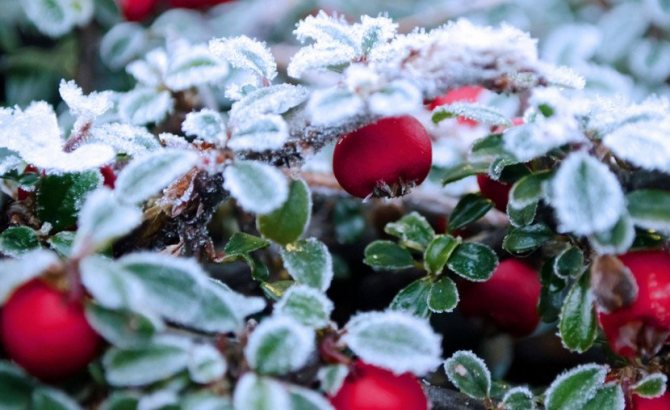

The harvested crop can be stored frozen, crushed with sugar, using the soaking method or canned. Fresh fruits can be stored in a cool room for six months, in a moistened place for about a year. If you follow simple but mandatory rules for care, the result is healing cranberries will thank you with a generous and healthy harvest.
What else is cranberry good for?
Daily consumption of 300 ml of cranberry juice allows men to increase their potency. This effect is due to enzymes that protect the genitourinary system from bacteria. Women use cranberries for weight loss, tannins in its composition stimulate metabolism. Fiber in berries not only activates the elimination of toxins and toxins, but also blocks the feeling of hunger. Fortified berries are extremely beneficial for children, they increase mental capacity, improve appetite and play a role in the formation of the skeletal and muscular system.
The healing power of the scarlet cranberry
Why should you plant a shrub on the site, spending some time and effort? Because you can create your own home pharmacy and make so many different berry dishes. Yes, cranberries do not differ in their sweetness and aroma, but if you know what it can, and the recipes by which you prepare real culinary masterpieces, then the opinion changes immediately.
So, cranberries in the garden are:
- powerful protection against colds, since the berry has the ability to fight all pathogenic flora;
- health support. Due to the vitamin composition and minerals, it strengthens the immunity of adults and children;
- stimulation of the secretion of gastric juice, and it helps to break down all food, thereby regulating the work of the gastrointestinal tract;
- a powerful antioxidant that removes toxins, toxins, congestion from the body, which in general affects our health and our appearance;
- assistant and those who are tormented by ailments of the genitourinary system;
- cancer prevention. Scientists, studying the beneficial properties of the beak, found that it can help in the difficult fight against cancer and serve as protection against it;
- fighter against pathogenic flora in the oral cavity.
The berry contains a lot of calcium, phosphorus, potassium, iron, iodine, manganese, silver, copper, phytoncides, tannins, vitamins and acids - citric, acetic, oxalic.There are pectins, they have a beneficial effect on our stomach, helping to fight gastritis. Natural gifts are fiber, which cleanses, normalizes the digestive tract and even contributes to weight loss. You can talk about the benefits for a long time, but the essence is already clear to you, we think that many summer residents and owners of their homes already want to plant culture. But first you need to know which varieties will yield a harvest and will not disappoint.
For information! Due to the large amount of acids, the leader among which is lemon, cranberries are called "northern lemon" or "lemon of the north".
Cranberry is a natural remedy
Cranberries are quite popular among not only traditional healers, but also certified doctors. Doctors recommend including this berry in the diet as a dietary supplement, and also as a natural antibiotic for inflammatory processes of the respiratory tract, kidneys and bladder, to prevent the development of scurvy. Anyone who is not indifferent to their own health needs to know what are the specific benefits of consuming cranberries:
- in terms of the content of vitamin C, known for its immunomodulatory and antipyretic effects, this berry is equivalent to lemons, oranges and grapefruits;
- cranberries contain vitamins K, A, many of the B group, which are necessary for the normal functioning of the nervous system and prevent the appearance of wrinkles and spots on the skin;
- vitamin PP (nicotinic acid) improves metabolic processes;
- a complex of trace elements will strengthen the skeleton, help maintain the shine of the hair, beautiful nails and a white-toothed smile;
- phenolic compounds, amino acids and pectins stop the growth of cancer cells and strengthen the walls of blood vessels, make them more elastic, thereby significantly reducing the risk of atherosclerosis and tumors of the mammary glands, intestines;
- proanthocyanidin prevents the growth of bacteria in the oral cavity, which favors good hygiene and the prevention of caries and periodontal disease;
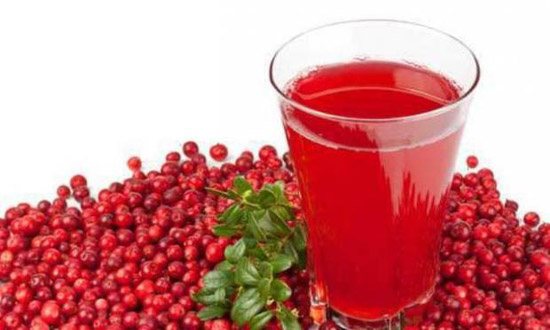

- polyphenol and pectin neutralize the harmful effects of radioactive substances and salts of heavy metals on the body, prolong youth;
- chlorogenic acids have anti-inflammatory, choleretic and diuretic properties;
- triterpenoids are close to the hormone secreted by the adrenal glands, therefore, they have a wound-healing effect;
- polysaccharides are effective against viruses, toxins, prevent the deposition of cholesterol on the walls of blood vessels, stimulate mental and physical activity.
Thus, the analysis of the biochemical composition can serve as an exhaustive answer to the question of whether wild-growing cranberries are useful. As for the berries grown in the summer cottage, it is worth noting that it is somewhat different in composition:
- large-fruited cranberries have more water;
- much less vitamin C.
This increases the palatability, but reduces the immunomodulatory effect. But garden cranberries have enhanced beneficial properties in terms of counteraction:
- crustaceans - carcinogens;
- inflammatory processes of the excretory organs.
This is possible due to the large amount of soluble fiber and chlorogenic acid. Otherwise, homemade large-fruited and small marsh berries are equivalent.
When are cranberries an irreplaceable part of the diet?
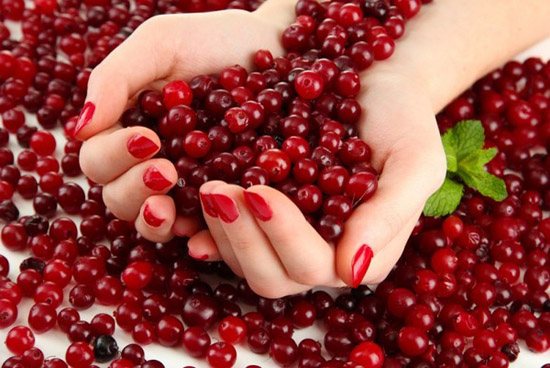

To maximize the benefits of cranberries, significantly increase their daily dose if:
- you are pregnant - this will improve placental blood circulation, prevent pathologies of intrauterine development of the fetus, minimize the risk of postpartum depression;
- you have a cold or infection with a fever;
- there is an increase in blood pressure, swelling;
- you are taking antibiotics and sulfonamides - cranberry enhances their effect;
- have problems with the cardiovascular system;
- you have been diagnosed with kidney and urinary tract diseases, digestive disorders;
- there is frequent inflammation of the gums;
- you live in an environmentally polluted area or eat foods loaded with harmful food additives.
Cranberry juice can also be used for wound healing, as a cosmetic to rejuvenate and improve skin condition. Knowing how fresh cranberries are good for the body, make this wonderful berry a daily treat not only for adult family members, but also for children, especially when they enter a period of active growth and movement.
When cranberries are harvested
The main ripening months for cranberries are September-October.
The early varieties are harvested in the middle of summer. At the same time, they try to berry to collect as it reaches maturity, which can be determined visually:
- When ripe, the cranberries take on a uniform reddish-brown color. The seed inside a ripe berry is brownish;
- An unripe berry is characterized by a pale, irregular reddish or yellowish color.
The harvested harvest of ripe berries is used for food, homemade preserves (compotes, jam), cranberry juice are made from it. Unripe berries are placed in boxes or containers and placed in the sun to ripen.
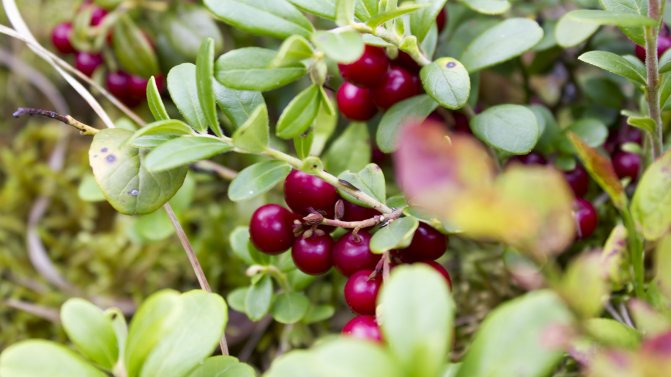

Ripe berry
Advice. In order to get a tasty and sweet berry, many gardeners collect overwintered cranberries in spring after the snow melts. With this method of harvesting, the berry ripens and gains the maximum amount of nutrients during its stay under the snow cover.

